FEATURING
Stories
First Chapters: "ABOUT FACE"
- Details
- Written by Carole Howard Carole Howard
- Category: Books and Writing Books and Writing
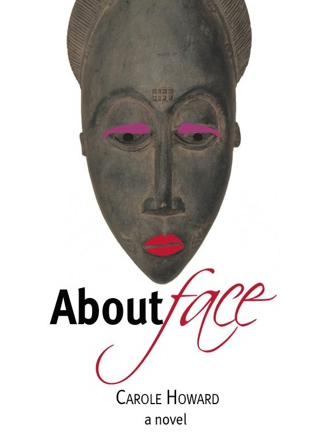
Chapter 1
RUTH TALBOT LOOKED DOWN and winced. She couldn’t believe today, of all days, she’d forgotten to change out of her commuter’s red high-top sneakers into the pumps that would complete her corporate camouflage. From the knees up, she fit right in at the big meeting with the new CEO in the ultra-elegant conference room with small oil paintings in ornate frames. But her feet belonged in the playground.
“I want that list of criteria to go out to all our vendors right away. Right away. So they’ll know exactly how Mimosa Inc. will decide whether they’re in or out,” said Jeremy.
The guy from Purchasing—was his name Ralph— answered, his voice dissolving around the edges like a milk-dunked Oreo. “We use quite a lot of vendors, actually. We always have. And some of the criteria we use for them are difficult to quantify. They’re intangible, really. We’ve always—”
“Intangible won’t do. No, no. Won’t do at all. We need to know exactly, precisely how to decide who we’ll do business with. Right away. Criteria on my desk by close-of-business tomorrow. Then out to the vendors next week.”
Poor Purchasing-guy. “Intangible” turned out to be a poor word-choice.
“Next, the splashy launch of ‘Lipsticks & Scarves,’” Jeremy said as he looked at Ruth with raised brows. “The results are … shall we say ... very disappointing.”
Disappointing? What’s he talking about? Ruth cleared her throat and spoke a little louder than was necessary. “These results are well within our standard for pilot programs. We can make them better, yes, you’re right about that. But that’s why we pilot, so we can tinker with the variables. Meanwhile, they’re quite decent.”
“Decent? Dee-cent, you say?”
Uh oh, she thought. Looks like “decent” goes in the garbage heap with “intangible.”
“Maybe they are what you call ... decent ... but no more than that. Maybe under previous management, that was good enough.” He looked around, making eye contact with everyone at the table, one by one, as if they didn’t already know he was the new management. “But not now. There’s a new sheriff in town, and now we need better than decent. We need a grand slam.”
“I agree, that’s the goal, a grand slam, but pilot programs are almost never grand slams. They’re usually singles. This one, I think, was even a double.”
I’m using baseball metaphors? How low can I go? Her disappointment in herself triggered the day’s first hot flash, a bit earlier than usual. The fire started somewhere in her chest and galloped through her neck, up to her head, while also traveling south. She felt every thread of her clothing against the sweat-sheen on her skin. To her amazement, people had said they didn’t notice anything, even when she thought she was ablaze.
“I was referring to a grand slam in bridge. All the tricks. Doubled and re-doubled. Lots and lots of points.” Jeremy smiled a quick, minimal smile, managing to move only the muscles at the edge of his lips but not engage his cheeks or eyes. With his dry skin, sharp nose, and darting tongue, he looked like a snake. Or maybe he just needed moisturizer.
“What do you plan to do about this, Ruth?”
Rather than walking around as she spoke and revealing her feet of canvas, she stood in place and grabbed the edge of the table. Richly grained walnut, highly polished, the color of dark rye toast with honey, it was the centerpiece of this room of beauty and good taste. Being here stimulated and calmed her senses at the same time, like walking along the beach.
The first few times at the table, she’d thought she could only say very important things. Now she knew the setting itself made anything sound very important. She concentrated on the rare pleasure of towering over people as she reviewed the figures that backed up their decision to launch the innovative packaging of lipsticks with matching scarves.
“The data told us loud and clear this was an idea worth pursuing. And the data were right, of course, based on our preliminary results. People didn’t mind buying a lipstick to match one scarf if the set was appealing and the price was right.” She looked over at Jeremy.
Disappointing? Don’t be ridiculous.
“Just out of cur-i-o-s-it-y … ” Jeremy dragged out each syllable with a deep, slow cadence to his voice, and Ruth could almost hear mournful cello music as accompaniment, “... who came up with this idea? Marketing? R&D? Perhaps even ... even Dean himself?”
After forty years at the helm, Dean had sold Mimosa to B&D, a conglomerate looking to “feminize their offerings,” as it said in the press releases. Jeremy had been B&D’s Senior VP of Operations and was chosen to transform Mimosa from a small touchy-feely family-owned business to a rootin’-tootin’ buttoned-down operation.
“You know, I honestly don’t remember,” said Ruth, catching a glimpse of Judy staring down at the table to avoid giving away her authorship. “Anyway, we work as a team, so it doesn’t really matter.”
She shuffled her papers for a second. “But you’re right, we can make our results better. Why don’t we turn our attention to how to do that.”
Disappointing, indeed.
The rest of the meeting was no more boring than usual, and they did come up with a plan to redesign the Lipsticks & Scarves campaign. Ruth hoped she and her sneakers could be the last to leave.
Ordinarily, she wouldn’t have cared so much—she was senior management, after all, and had been at Mimosa for twenty-five years, so people paid more attention to her track record than her track shoes. But Jeremy had gotten rid of a bunch of people soon after he took over, quietly, no muss no fuss. Certainly, sneakers were not grounds for dismissal, but she didn’t want to get off on the wrong foot. So to speak.
She took as long as she could to put her papers together and enter notes into her organizer/planner. Red for meetings, green for phone calls, blue for To-Do List entries. Pat Givens, Ruth’s Assistant Product Specialist, made nice to Jeremy on her way out. Did she actually say she enjoyed the meeting?
But Jeremy out-waited Ruth. “I’ll see you at the benefit tonight,” he said to her.
Facing Jeremy in his perfectly-tailored suit, conservative tie, and bookish horn-rimmed glasses, she was glad she’d dressed the part for today’s meeting, invoking her standard rationalization: “It’s not phony, it’s effective packaging, as if I’m one of our products, sitting on the shelf to be seen and evaluated.”
She knew she undercut the gray suit and pearls by gelling a few spikes in her short, dark hair—the kind of spikes usually seen on 20-year-olds with multiple pierces. Oh well, her whole life was a mixed message anyway. There was the normal middle-aged middle-class corporate executive who lived in the suburbs, and then there was the overgrown hippy. Trying to integrate the two parts of her identity felt like juggling three live chickens. On an inclined plane. In high heels.
“I’m glad you’ll be there. It’s clear we disagree about the status of the Lipsticks & Scarves results, but I’m sure we’ll agree about raising lots of money for a worthy cause. I think we’ll set a record tonight. And we’ll get great publicity in the process.”
“I love opera. Turandot is one of my favorites.”
Jeremy told Ruth he wanted to follow the re-design of the Lipsticks & Scarves campaign very closely. It was his way of delving into the actual work at Mimosa. He was in high guy-talk mode as he said he wanted to penetrate, wanted to get his hands dirty. Especially the Marketing Department, which he called the heart and soul of any company. He told her to let him know about everything connected to the campaign. Everything.
This is not good, she thought. Yes, the Marketing Department is important. Yes, he needs to understand the work of the company. No, looking over her shoulder is not the way to do it. She wasn’t some entry-level newbie who needed close supervision. That second “everything” put her on alert.
“How about if I—”
“Just send me the relevant material as it comes up.” He looked at the antique clock on the wall, then at the expensive watch on his slim wrist. “I’ve got to go.” He looked down at her feet. “And I guess you’ve got to jog back to your office.”
On the way back to her own little piece of Mimosa real estate on the other side of the eighteenth floor, Ruth thought it was going to be hard to break in this new CEO. It was clear he wasn’t going to be the “I want to be your friend” type of boss. More like the “Me Tarzan, You Jane” kind. Or maybe “Control Freak.” Two control-freaks battling it out, she thought. Not a pretty sight.
And someone was going to have to teach him the value of intangibles. She hoped it wouldn’t have to be her.
Once, as a Peace Corps volunteer, she’d tried to convince a villager to incorporate vegetables into the traditional fish-and-rice diet because of good things called vitamins. The woman shifted the baby on her back, reached into her basket for a lumpy whitish tuberous yam, and held it close to her eyes.
“You can’t see them, they’re very small. But they’re there.”
Thankfully, she was more successful than Purchasing-guy had just been. She wondered what that twenty-three-year-old version of herself would have thought of this fifty-three-year-old version, the Marketing Director of a cosmetics company. Actually, she didn’t really wonder, she knew.
Back then, she lived in a hut with one orange crate for clothes and one for books. She was saving the world, or at least making a difference to the people in her village. Every moment of every day was, if not giddy—she did experience homesickness and doubt, not to mention diarrhea—at least related to every other moment, directed either at her worthy goals or physical needs. The individual cells in her body felt more than just alive, they fairly vibrated. A far cry from talking about selling cosmetics.
Had it been thirty years or thirty light-years? Why can’t her past and present finally learn to shake hands and play nice?
Rather than explaining to her imaginary younger self that the compromises she’d made in her life were justified—“I had to earn enough to send Josh to college; besides it’s not just makeup, it’s skin care, too”—she strong-armed the thought from her consciousness with an audible “Oh well.”
Her staff had gotten to her office before she did. When she joined them, they were ready to pounce. “Lordie, lordie, Ruth, that was ... well ... it wasn’t great, you know? Don’t you agree? I mean ...” Judy somehow managed to wring her hands and bite her thumbnail at the same time.
“It was abundantly clear that Jeremy didn’t like our results,” said Pat. “But I wouldn’t disagree with his priorities. Profits are the name of the game.” Her deep voice, always surprising from such a small body, made crankiness and anxiety difficult to distinguish.
“Profits certainly are important, Trish.” She saw Pat flinch at the use of her childhood nickname and start to tap the toe of one tasteful navy-blue pump like a metronome. It was a low blow, Ruth knew, but so was disloyalty.
Tom interrupted his choppy, disconnected gait. “What did you think of the meeting?”
“It was the first launch under Jeremy’s watch, so let’s assume he’s being a little defensive. He did pretty well at B&D, so he must know something. And he clearly has his own style,” she said with as straight a face as she could muster, “but that’s the way it goes. He’s the boss. We have to get used to it.”
No need to worry them yet. She felt the vertical crease between her eyebrows starting to deepen into the Grand Canyon of the Forehead as the antagonists in her familiar internal battle started warming up: Why did she do this job? Because she liked it. Why did she like it? For the creativity and the validation of her talent. Was that enough, and was it time to leave? Yes, and don’t be ridiculous.
Turning to the Lipsticks & Scarves redesign, they constructed an action plan and divided the tasks to be done, from manufacture to packaging to advertising. Later, when their work started to bear fruit, she’d think about “keeping Jeremy informed,” whatever that meant.
For the moment, though, the few last-minute details for tonight’s benefit were numero unoon her prioritized To-Do list. She’d take care of them and then, she hoped, be able to leave early. It probably didn’t even pay to change out of her sneakers.
TO READ THE REST OF THE BOOK, CLICK HERE.
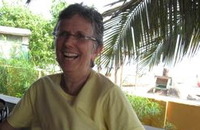 CAROLE HOWARD has published short fiction, personal essays, and a walking guide to Paris. She has traveled extensively, visiting and/or volunteering in about 40 countries, including 15 in Africa. Her African experiences inform About Face.
CAROLE HOWARD has published short fiction, personal essays, and a walking guide to Paris. She has traveled extensively, visiting and/or volunteering in about 40 countries, including 15 in Africa. Her African experiences inform About Face.
She says, "Inspiration came while I was on vacation in Essouira, Morocco. (I travel a lot. Big surprise.) I received a phone call about a long-awaited go-ahead for a project with a big, prestigious client. That’s when a funny thing happened:
In a couple of nanoseconds, I made the trip from “HURRAY, WE GOT IT!” to “I don’t think I really want to do this.” Emotional whiplash.
But at the same time I was experiencing it, I was observing myself experience it. Very interesting. And that was the germ of the idea. There’s a lot more to it, of course. There’s Africa, there’s makeup, there’s menopause, there’s ....
.... you’ll find out when you read it.
Carole lives in New York State's beautiful Mid-Hudson Valley with her husband. When she is not being a writer, a wife/mother/grandmother, or a globe trotter, she practices Iyengar yoga or plays the violin in a community orchestra.
For more about Carole Howard, visit her website at http://www.carolehoward.com
Waking Up to Comedy
- Details
- Written by George L. Nitti George L. Nitti
- Category: Health & Spirit Health & Spirit
 Reading a few pieces recently on the life of Nora Ephron and of course her sad and unfortunate death at only 71, and also having a phone conversation with my mother, who has always been a big fan of finding comedy in life (she divorced my serious surgeon father for a salesman who likes to clown and harrass strangers with his humor), I thought I’d give a stab at writing something comic - for a change. After all, before I got into tragedy, I was kind of funny - interested in making others laugh through stand-up comedy and sitcom writing. My standup comedy days were short lived though, exactly six miserable performances, when I decided I didn’t like trying to make people laugh (I like making them cry). It was actually harder than I thought as I found myself sweating bullets to try to elicit laughter. And then there was the high school teaching job I didn't get for taking so seriously the literary value of Frasier, Seinfeld, and The Simpsons. I don't advise arguing the point at your big interview that sitcom writing is great literature in the face of a hiring committee that thinks Jane Eyre, Hamlet and the Great Gatsby are the cat's meow. Oh well, I shouldn’t have taken comedy so seriously then. It had neared killed me and also my chances for gainful employment. But in the immortal words of Annie Hall, "La Di Da, La Di Da."
Reading a few pieces recently on the life of Nora Ephron and of course her sad and unfortunate death at only 71, and also having a phone conversation with my mother, who has always been a big fan of finding comedy in life (she divorced my serious surgeon father for a salesman who likes to clown and harrass strangers with his humor), I thought I’d give a stab at writing something comic - for a change. After all, before I got into tragedy, I was kind of funny - interested in making others laugh through stand-up comedy and sitcom writing. My standup comedy days were short lived though, exactly six miserable performances, when I decided I didn’t like trying to make people laugh (I like making them cry). It was actually harder than I thought as I found myself sweating bullets to try to elicit laughter. And then there was the high school teaching job I didn't get for taking so seriously the literary value of Frasier, Seinfeld, and The Simpsons. I don't advise arguing the point at your big interview that sitcom writing is great literature in the face of a hiring committee that thinks Jane Eyre, Hamlet and the Great Gatsby are the cat's meow. Oh well, I shouldn’t have taken comedy so seriously then. It had neared killed me and also my chances for gainful employment. But in the immortal words of Annie Hall, "La Di Da, La Di Da."
Anyway, I run the gamut between the two extremes, sometimes dark and heavy while of late less light than normal. Sounds like I'm making coffee here but really it's much deeper than coffee. Very, very deep stuff. Please don’t ask me why things are tending to the grave side (I've been taking pictures of cemeteries lately, finding beauty in marble. Does that help explain anything?) Anyhoo, I’m not looking for your sympathy. It’s not the recent death of a father, nor the perennial struggle to make a living, nor my Chihuahua that keeps me up in the middle of the night as it suffers from a bout of diarrhea or the thousand other slings and arrows coming at you as the twilight of life approaches and you look back and wonder where the hell it all went. See how I lean towards the morose and I'm not even fifty yet? I can’t help myself. I don’t know how Nora was able to do it so well, to have that comic touch, in so many serio situations. Divorce inherently isn’t funny, but I guess it’s how you handle it that makes it so. She had a knack for finding humor in it. And finding humor in relationships. And conveying that in art.
Truth told, somehow I prefer poetry to match my heaviness, rather than comedy to create levity. Rarely am I light like taffy before I find it entangled in the mouth. In trying to spit out the jumbled words, I have fallen prey to the weight of ever rising taxes, a slugglish economy and the woes of common folk all mired in getting through the daily grind. Please, I don’t want to hear about the little things going on in your life-another brake job around the corner or how your kids are bleeding you for another dollar of your hard earned money. Get rid of the car and get rid of the kids and add some black humor to your life. And a little sugar to go with it all.
When you get to that point of sourdom, as you are putting up your precious children for auction, it may be time to inject life with the sweet scents of humor. Of course for their benefit. And yours too! Where do you find the comedy? In yourself, to start. You find it at the end of the lines you are scripting, as you are catching yourself droning on about the hardness of things and the absurdity of your implacable situations, when you realize in mid-sentence that your life is more pliable than you might have thought and that you can change the outcome with the turn of a phrase. It’s looking for opportunities to twist the narrative of a sad saga with a tap dance routine by Fred Astaire and Ginger Rogers even if your cast of characters are as clumsy as a pair of new born phillies trying to stand on their own feet (A little heady for comedy but you get the point).
I am far from an expert at what constitutes comedy, but I am going to pay attention to the endings I’m infusing my stories with, looking for the twists that turn tragedy upside down to make things funnier. I’m going to start, first by rewatching my favorite movies of Nora Ephron, and then catching a few more comic movies on my summer’s list while working to regain that side of myself o’ertaken by the dark side. I will also pick up the phone, call my mother, tell her I love her, and thank her for her wisdom for reminding me to lighten up and embrace the comedy that life has to give, for the punchline is that time here is finite so enjoy it while you can - starting with a good dose of laughter.
You can make em' laugh. I know you can.
Landmark Inn: A Window into History and Contemporary American Cuisine
- Details
- Written by George L. Nitti with Kerryl Ann Ebneter George L. Nitti with Kerryl Ann Ebneter
- Category: Food & Wine Food & Wine

"1954: the year that was!" These were the handwritten words covering a faded Warwick Dispatch Newspaper from the same year. It was the year communist fears spread worldwide and the fall of Senator Joe McCarthy finally came about; the year that global tensions peaked and polio vaccination became available; the year the NY Giants swept the World Series and Marlon Brando appeared in “On the Waterfront” while “Fly Me to the Moon” shot to the top of the record charts. And in the same year, in the quaint, country setting of Warwick, 1954 was the year Gordon Richardson and his wife Cynthia purchased a historic farm stone house originally owned by blacksmith Conrad Sly, then known as the Sly House, giving birth to the Landmark Inn.

For the next twenty years, the Landmark would become a favorite neighborhood haunt, as it served up traditional American victuals like Filet Mignon, Roast Turkey, Baked Ham, Double Cut Veal Chops, Sirloin Steak, and classic seafood dishes. The menu was also accompanied by savory sauces and side dishes.

Warwick historian Dr. Richard Hull, who was a teenager at the time, remembers being amongst its very first customers. “It was a Sunday lunch after a cold morning of hard work planting apple trees on the farm. Dad treated me to a sumptuous lunch and Gordon Richardson showed me that wonderful map of Paris in the late 18th century, which is still on the Inn’s Wall!”
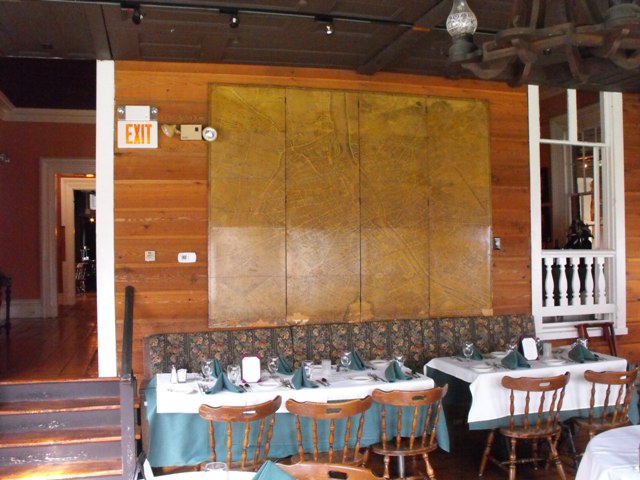
As the years passed and America entered the decade of the 60’s and early 70’s, the Landmark hit its stride, becoming the center of nightlife where everyone, the young and old, could meet and talk across generations. Hull, who would return time and again to the Landmark amidst a warm welcoming fondly recalls: “The Landmark was always a place where people met – Richardson was a community activist. It was more than just a tavern – it had cultural and outdoor events, such as Hawaiian luas.” The Warwick Dispatch noted, “The Hawaiian Luas were vigorously opposed by some local officials because they were held on Sundays but well attended nonetheless.”
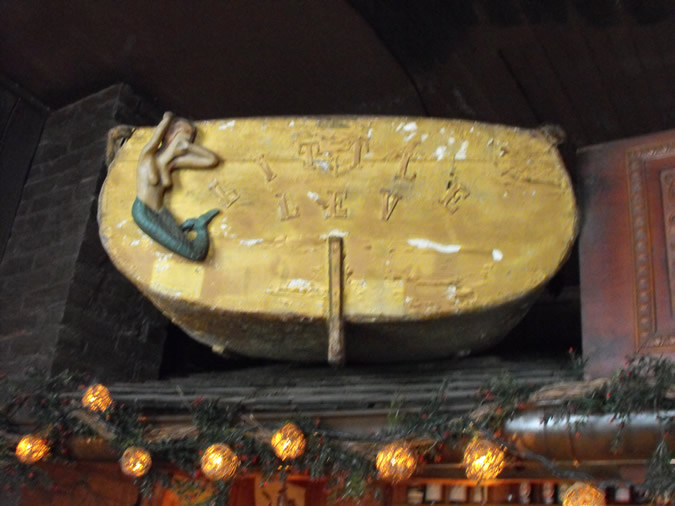 Richardson, who died in 1991, according to Hull was quite a character. “He was a great raconteur – he engaged you in conversation. He was a ship Captain on the Great lakes. He’d regal you with stories that fired your imagination. He was an accomplished watercolorist, a man of many talents while his wife Cynthia came from an old dutch family and also liked to tell stories. They complemented each other. He ran the bar while she was responsible for creating its fine dining.”
Richardson, who died in 1991, according to Hull was quite a character. “He was a great raconteur – he engaged you in conversation. He was a ship Captain on the Great lakes. He’d regal you with stories that fired your imagination. He was an accomplished watercolorist, a man of many talents while his wife Cynthia came from an old dutch family and also liked to tell stories. They complemented each other. He ran the bar while she was responsible for creating its fine dining.”
In the mid 70’s and 80’s, after Richardson had sold it to Steve Kasmar, the Landmark shifted focus to its bar business and continued to prosper. In 1989, after a major renovation, the business was sold again but this time languished. By 1993, Michael DiMartino, a graduate of the Culinary Institute, was introduced to the property, which had been up for sale again. After working as a chef at the Clarksville Inn, a Rockland County restaurant, he bought the property. With his acquisition, the Landmark would return to another distinctive era of fine dining, characterized by contemporary American cuisine, without losing its sense of history.
 As a history buff himself, DiMartino would carry on the historical tradition, showcasing his personal collection of antique cameras, a set of printer’s type belonging to his father, and an old NY Times front cover from 1969 announcing the first landing on the moon. He also made sure that its rich history stayed intact, maintaining many of the restaurant’s historic attributes like the famous ceilings created from the old doors of the Red Swan Inn. Greg Masefied, a lifelong resident of Warwick and a good friend of Richardson helped put the doors up on the ceiling, noting that it was the cheapest thing we could find, necessity being the mother of invention. Other remnants of those former days include the dining tables supported by old, foot-driven sewing machines made by a Tuxedo sewing company; the old map of historic Paris; the hull of an old boat once owned by Richardson, and so much more coming from every pore of the structure. In the bar, when owned by the Richardson’s, DiMartino sadly noted, “Originally the walls were covered in postcards people sent from their travels. It’s too bad that we lost that piece of history after its last renovation.”
As a history buff himself, DiMartino would carry on the historical tradition, showcasing his personal collection of antique cameras, a set of printer’s type belonging to his father, and an old NY Times front cover from 1969 announcing the first landing on the moon. He also made sure that its rich history stayed intact, maintaining many of the restaurant’s historic attributes like the famous ceilings created from the old doors of the Red Swan Inn. Greg Masefied, a lifelong resident of Warwick and a good friend of Richardson helped put the doors up on the ceiling, noting that it was the cheapest thing we could find, necessity being the mother of invention. Other remnants of those former days include the dining tables supported by old, foot-driven sewing machines made by a Tuxedo sewing company; the old map of historic Paris; the hull of an old boat once owned by Richardson, and so much more coming from every pore of the structure. In the bar, when owned by the Richardson’s, DiMartino sadly noted, “Originally the walls were covered in postcards people sent from their travels. It’s too bad that we lost that piece of history after its last renovation.”
19 years later, DiMartino is going strong. “I love what I do and I think that’s the key to my longevity.“ Kerryl and I had the pleasure of dining at the Landmark in April. We could have eaten in the cozy and rustic bar area, which we have enjoyed on many occasions, where the beams and floorboard date back to the Sly Homestead and its original founding in 1778; but we chose to eat in the main dining room, which is considered the original Landmark Inn, surrounded by the beauty, craftsmanship and mastery of days past.

From the presentation of the bread basket to our splendid desserts, the meal could not have been better. We started the evening with the Lobster Egg Rolls, which were crispy and succulent, and three delectable Maryland Crab Cakes, which were sautéed to perfection, filled with plenty of lump crab meat and topped with roasted pepper cilantro. When we asked for a side of tartar, it was no problem, made from scratch and delivered pronto. Then we shared the Salad of Roasted Beets, which contained walnuts and generous portions of goat cheese blended with a light coat of balsamic dressing.
At this point, having been so happy with our appetizers, salad, and treats from the yummy bread basket, which consisted of homemade bread, muffins and tasty flatbread, we were truly looking forward to our main entrees. We decided to go with the grilled Filet Mignon with a pink peppercorn sauce and one of the night’s specials - Lamb Shank braised in a red wine made from the Warwick Valley Winery. The filet was very tender and the lamb fall of the bone, with a demi-glace that was delicious! I substituted mashed potatoes for the polenta and Kerryl loved her hand-cut potatoes while the vegetables were cooked just right on both dishes.
To complete our tour de force dinner, we added a flourless and rich chocolate torte and several scoops of creamy vanilla ice cream with fresh pureed raspberry sauce that was heavenly and that we could not stop eating because it was so delicious. We were surprised to learn and happily so that the Landmark makes its own ice cream with only all pure natural ingredients, a testament to DiMartino that when you do a lot of little things right they add up to make a big difference. This perhaps explains why his business is doing so well and is the key to his longevity. His passion and knowledge for food (and wine) abounds as we had the privilege of discussing with him a broad range of topics related to food and wine.

Kerryl and I tend to the finer points of dining and appreciate quality. We could not leave out our appreciation of even the exquisite menus, which are handcrafted with cherry wood and have a copper embossing of the Landmark Inn and its historic name. We are happy to report that the Landmark Inn is alive and well, producing fine food while maintaining a mix of décor that would make anyone feel at home. We are looking forward to returning for another enjoyable meal, from start to finish, and being transported back in time. See you there!
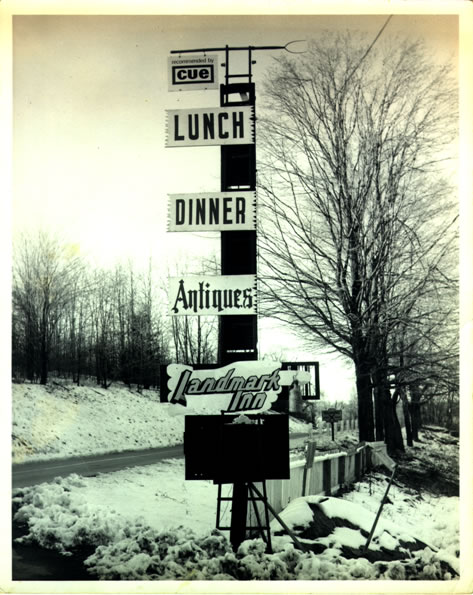
Special thanks goes to the Warwick Historical Society and Warwick Archivist, Sue Gardner, for providing several articles of source material as well as Michael DiMartino, who shared his knowledge of the history and several old pictures.
Warwick and the Making of the Appalachian Trail
- Details
- Written by Prof. Richard W. Hull, Town Historian Prof. Richard W. Hull, Town Historian
- Category: Education Education
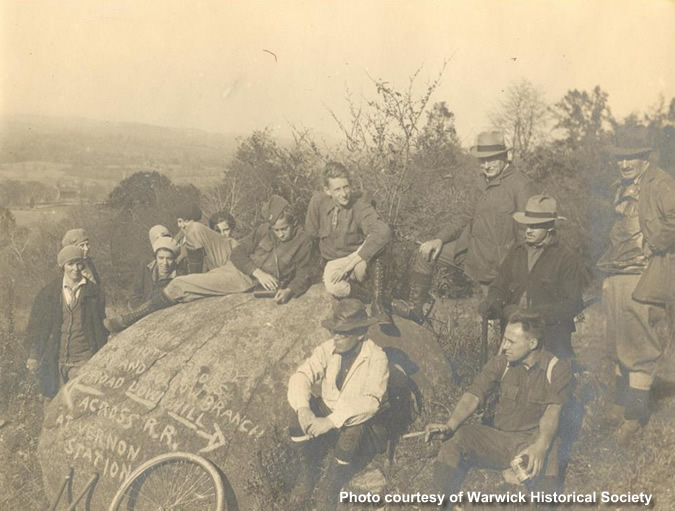
Many Lenape Indian trails crisscrossed our local valleys for centuries. Some extended for only a few miles, others for hundreds. European fur trappers and ultimately colonial farmers used them before they built roadways for their wheeled vehicles. Some colonial roads, like Kings Highway and Route 94, were constructed over these ancient paths. Many of our local town roads, like Ridge Road, evolved from these vital human corridors.
 In the late 19th century, when the Conservation Movement got underway in America. Warwickians began to acquire an interest in the natural beauty of our area and nature walks became popular. Our fascination with local flora and fauna was revived. These intrepid hikers fell under the influence of the romantic landscapes of world famous Hudson River School artists, notably our local painter, Jasper Cropsey, as well as local naturalists like J.H. Crissey and Audubon Wilder. They revived old Indian trails and blazed new ones in the more remote and mostly mountainous wooded parts of our community. And they attracted nationally-known naturalists like the prolific essayist John Burroughs (1837-1921). They were also inspired by Theodore Roosevelt and our emerging national parks.
In the late 19th century, when the Conservation Movement got underway in America. Warwickians began to acquire an interest in the natural beauty of our area and nature walks became popular. Our fascination with local flora and fauna was revived. These intrepid hikers fell under the influence of the romantic landscapes of world famous Hudson River School artists, notably our local painter, Jasper Cropsey, as well as local naturalists like J.H. Crissey and Audubon Wilder. They revived old Indian trails and blazed new ones in the more remote and mostly mountainous wooded parts of our community. And they attracted nationally-known naturalists like the prolific essayist John Burroughs (1837-1921). They were also inspired by Theodore Roosevelt and our emerging national parks.
The idea of connecting these disparate trails and opening them to the wider public was promoted in the early 1920s by a prominent Connecticut Judge, Benton MacKaye. It was he who apparently conceived of the idea of an Appalachian Trail, a footpath that would extend continuously from Mount Katahdin, Maine, to Mount Oglethorpe in Georgia, some 2180 miles. In 1925 the Appalachian Trail Conservancy was created to coordinate the undertaking. To make it happen, communities along the proposed route were asked to form trail clubs and to provide the necessary volunteer workforce for their designated sections .
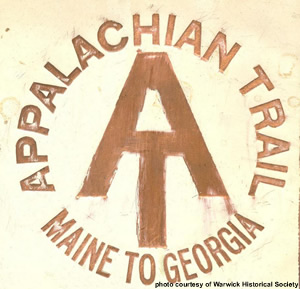
Warwickians were among the earliest and most eager proponents of the trail concept. And by 1930 the Warwick group, under the leadership of local banker Raymond Goodlatte, Advertiser publisher Hiram P. Tate , pastor Taber Knox, and naturalist George Hansen were mobilizing the Boy Scouts and other community groups to begin the arduous task of trail blazing. Most of the affected landowners were proud to have a trail of national significance traverse their properties. And over subsequent years some made land donations to the New York/New Jersey Trail Conference, a non-profit entity.
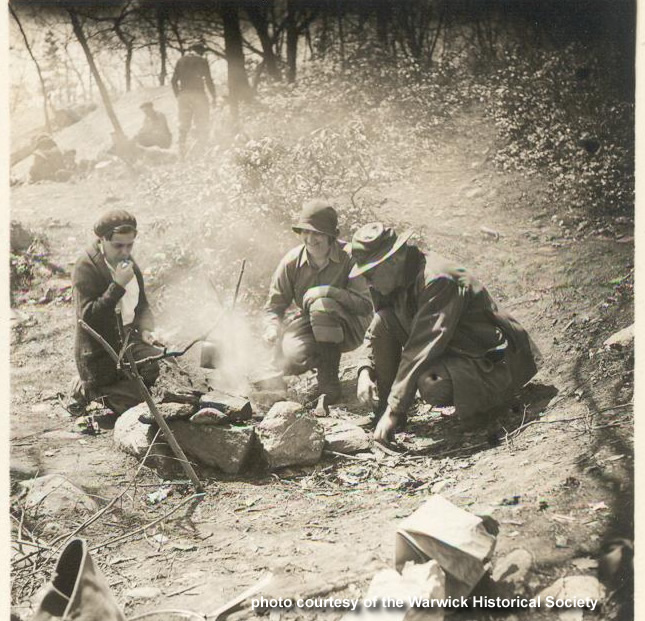
Amazingly, by June 1931, fully six years before the entire Appalachian Trail was officially dedicated, the more than ten-mile long stretch through our town was opened to hikers. Our section of the trail began near Fitzgerald Falls and Dutch Hollow in the Greenwood Lake/Monroe borderlands along County Route 5. It then climbed steeply to the summit of Bellvale Mountain and southwards along the ridgeline to Mount Peter, cutting through abandoned farms, following old timber trails and remnants of Indian paths. From Mount Peter the trail continued southward along a ledge from which one obtained a spectacular view of Greenwood Lake below. It continued past the wetlands of Furnace Brook then sharply upwards to 1350 foot Prospect Rock . Later in the 1930s the trail between the Bearfort range and the Vernon Valley was modified to cross the Longhouse Creek, then onward to an old road used by the defunct Centennial Iron Mine. From there it crossed Brady Mountain road and ultimately joined the Wawayanda Cedar Swamp road which led to Lake Wawayanda past an old iron furnace near the lake’s outlet. Beyond this, one crossed a dramatic escarpment on the west side of Wawayanda Mountain. It then descended to the Wawayanda Creek, across the Pochuck Creek and then up the eastern ridge of Pochuck Mountain and beyond to Unionville and westward some eight miles to High Point. In the 1930s Warwick’s Trail Group was largely responsible for the delimitation, construction , marking, and maintenance of this key section of the Appalachian Trail.
The trail wends its captivating way past rock ledges and shelters, deep ravines, ecologically-rich ponds, vital wetlands, and biological communities of rare cedars and hemlocks. Remarkably, much of this land remains in an undisturbed pristine state.
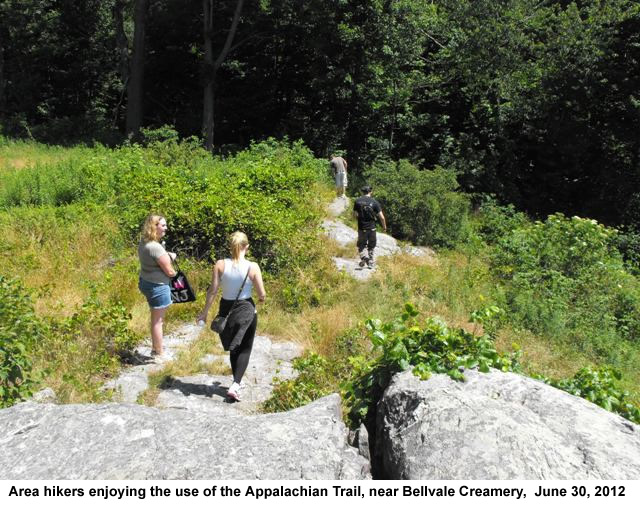
Warwick was an early leader in New York State in inserting into the 1973 revisions to its zoning code the prohibition of any construction within 200 feet on both sides of the Trail. Other communities would follow in the years ahead. Much credit for this law goes to local conservationists Pat McConnell, Tavy Umhey, and Tom Waleski. Also, since the late 1980s, even larger swaths of adjacent lands have been placed under protection by private land trusts, conservation easements, and government-owned public parklands and restrictive open-space zoning. Warwick was a regional leader in working towards open space preservation with the adoption of its innovative Master Plan and Zoning ordinance in 1987 and 1989, respectively. Since then it has been a leader in New York State in saving open space by purchasing development rights over key farms and woodlands within the vicinity of the Trail.
In light of these extraordinary achievements it is entirely fitting that on June 30th Warwick was designated as the first official ‘Appalachian Trail Community’ in New York State. Kudos to those visionary citizens who for more than a century have been at the forefront of conservation.
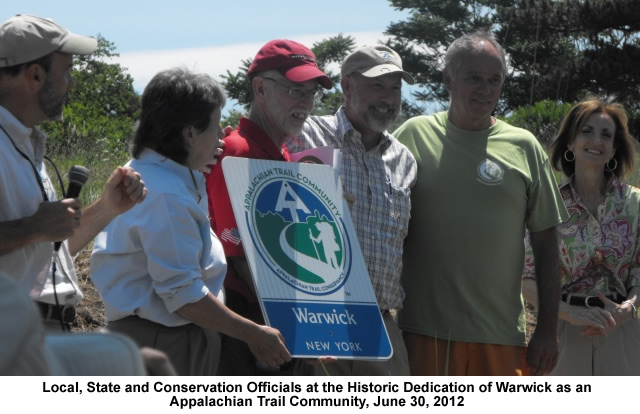
Omar Bradley, General at War - Review and Excerpt
- Details
- Written by John F. Nitti, MD John F. Nitti, MD
- Category: Books and Writing Books and Writing
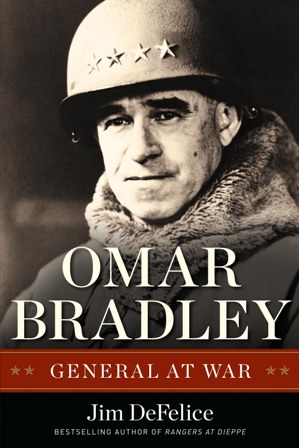 The book, Omar Bradley, General at War, by Hudson Valley Writer Jim DeFelice, written in 2011, is the story of a midwestern American boy's life's journey from a life of poverty to his good fortune of admission to West Point, the US ARMY and ultimately to US General. Bradley's role in World War II included North Africa, Sicily, and ultimately DDAY, the Battle of the Bulge, and the defeat of Nazi Germany.
The book, Omar Bradley, General at War, by Hudson Valley Writer Jim DeFelice, written in 2011, is the story of a midwestern American boy's life's journey from a life of poverty to his good fortune of admission to West Point, the US ARMY and ultimately to US General. Bradley's role in World War II included North Africa, Sicily, and ultimately DDAY, the Battle of the Bulge, and the defeat of Nazi Germany.
Unassuming, nonflamboyant, compared to Patton or the British General, Bernard Montgomery, Bradley was a great tactician. It was during the early fighting that Bradley was discovered to be a general concerned with the welfare of his troops. He lived most of the war in a truck. He loved mathematics and excelled at baseball on West Points' varsity team. It was there that he would meet, amongst others, Eisenhower, in his 1915 class. General George Marshall found him especially trustworthy.
As his career developed he encountered George Patton as his neighbor when stationed in Hawaii. Patton was flamboyant, loved entertaining and showing off, while Bradlley who had married his childhood sweet heart preferred a quiet life. In Sicily, Patton got into severe trouble over an incident of his slapping a non-wounded patient suffering from battle fright. Covered by the media, word spread as the story could not be contained. Thus, in preparing for D Day, Patton's role was that his army would be aimed at Calais, rather than at Normandy. Patton would redeem himself later, especially in the Battle of the Bulge. Omar Bradley, working under Patton in North Africa after the Kasserine Pass debacle reorganized US forces in North Africa.
Omar Bradley is a fascinating, detailed and descriptive story as DeFelice describes the unassuming Bradley, comparing him with other notable generals the likes of Montgomery, Eisenhower and Patton.
Excerpt from the book Omar Bradley: General At War by Jim DeFelice, a Hudson Valley writer:
Introduction
First Impressions
Northern Africa, February 23, 1943
The C-54 Skymaster ducked down from the clouds, its Pratt & Whitney radials pulling it toward the long, tan dagger jutting into the azure ocean ahead.
Africa.
As the plane dropped lower, green blotches appeared: trees spared the fury of the working bulldozers that razed the nearby land, turning it burnt yellow even as the aircraft dropped. A short, precariously narrow gray line appeared in the sand ahead. Ants were running near it.
Not ants, but men. Not a line but a runway, unfinished. The men were laying steel planks to widen and extend it.
General Omar Bradley, stiff and tired from a flight that had begun the night before inBrazil, roused himself and gazed out the window.
“We’re landing, sir,” said Chet Hansen, one of the general’s two aides.
Bradley nodded. Taciturn, he continued to gaze out the window as the military transport bumped onto the steel grid, its wheels whining. A gust pushed the aircraft hard to the side as it landed; the Air Corps pilot mastered it, keeping the drab green airliner on the runway as he feathered the engines and went hard on the brakes. The short strip gave him little room for error.
The same might be said for the tens of thousands of Americans stretched out between the airport and the far-flung foothills ofTunisiawell to the east. Three months before, the troops had landed inNorth Africa, full of hope and vigor, sure that they would bring the war against the Axis to a quick and victorious conclusion. Now they weren’t so sure. Their offensive had stalled badly. The reality of war had proven considerably more frightening than most had thought possible. Facing experienced German veterans, they had stumbled badly. Indeed, things were worse than most realized, as they had benefited from a good portion of luck at the start of the campaign, unnoticed as it may have been.
Luck had run out in a pass far to the east in Tunisia. There the young American force had been severely whipped in a mountainous area known as Kasserine Pass. At roughly the same time the C-54 was setting down, the architect of their defeat was repositioning his Panzers, threatening a strike that would break the young force entirely.
Bradley rose from his seat and made his way to the door with a mixture of anticipation, energy, and undoubtedly some apprehension. Though he was a general, he’d never been this close to war before. Though he was regarded as a master tactician—and had instructed thousands in the art—his plans had never been put to the test of real combat. And though he was held in the highest esteem by men who had already proven themselves under fire, he himself had never heard an angry bullet crease the air nearby. At fifty, he was a virgin to combat.
This would not have mattered much if he was coming to take a staff job, or even if he intended only to fulfill the role of an observer, in theory the job he had been assigned. But Omar Nelson Bradley, while modest in speech and demeanor, had ambitions that extended beyond the job of advisor or assistant. He wanted desperately to lead men into battle. He wanted to win, and he wanted to kill.
Nor had the man who sent him across the Atlantic intended that he merely observe. U.S. Army Chief of Staff George C. Marshall, who’d known Bradley for years, believed he could help turn the faltering U.S. Army around. Originally opposed to the African campaign, Marshall had come to see it as a crucial test for the still inexperienced army. It was a test that it had to pass, or it would suffer the most dire consequences.
* * *
Author Bio:
New York Times bestselling author Jim DeFelice is a long-time Hudson Valley resident who has lived in Dutchess, Ulster, and Orange counties. He’s written more than 30 novels and military histories that explore the moral questions of war, politics, and heroism.
A frequent collaborator with Larry Bond (Red Dragon Rising), Dale Brown (Whiplash), and Richard Marcinko (Rogue Warrior), Jim's solo books include the novels Leopards Kill, Cyclops One, and Coyote Bird, and the military history Rangers at Dieppe.
His newest book, Omar Bradley: General at War, published in September 2011, is the first in-depth biography ever written on the West Point graduate, who planned and led the Normandy Invasion on D-Day.
To sign up for a free email series Hallmarks of Good Leadership, based on Omar Bradley’s speeches and papers, send your name and email address to This email address is being protected from spambots. You need JavaScript enabled to view it.
Jim's websites are www.jimdefelice.com, and www.rangersatdieppe.com. You can follow him on Facebook at Jim DeFelice author page or through Twitter @jimdefelice.
Reviewer Bio:
 John F. Nitti, MD, who passed away on May 9, 2012, was a surgeon who spent most of his adult life practicing medicine at The Valley Hospital and raising a family in Ridgewood N.J. He spent two years in Japan during the Vietnam War where he operated on wounded U.S. soldiers, saving the lives of several young American military men, for which he received the grateful appreciation of many distraught parents of U.S. servicemen and women.
John F. Nitti, MD, who passed away on May 9, 2012, was a surgeon who spent most of his adult life practicing medicine at The Valley Hospital and raising a family in Ridgewood N.J. He spent two years in Japan during the Vietnam War where he operated on wounded U.S. soldiers, saving the lives of several young American military men, for which he received the grateful appreciation of many distraught parents of U.S. servicemen and women.
As president and founder of the Valley Hospital History Club, for over 20 years, Dr. Nitti organized countless lectures and programs. It was his lifelong love and passion of history that kept him involved in reading histories like DeFelice's Omar Bradley up to the very end of his life. He will be deeply missed.
Resurgence of Interest in Surrealism
- Details
- Written by James Antonie and George L. Nitti James Antonie and George L. Nitti
- Category: Art and Photography Art and Photography
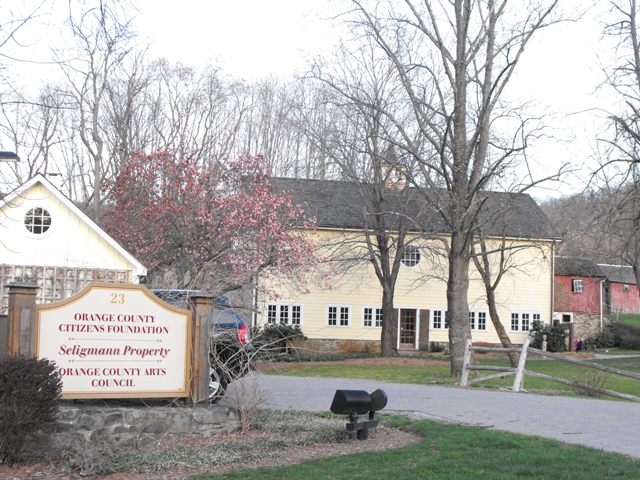 There’s been a resurgence of interest in surrealism in Orange County, NY, most notably and of late at The Seligmann Estate in Sugarloaf, NY. On March 30th an art exhibition, "A Homage to Kurt Seligmann," curated by Jonathan Talbot and Jessica Lawrence, was one in a series of events over the last year bringing to light some of this exciting activity. The show was packed with enthusiastic viewers and showcased local artists working in the medium of collage to pay homage to the life of Seligmann. Although Seligmann himself was not a collagist, surrealism has been important to the development of collage, as in the case of Max Ernst, one of the primary pioneers of the Dada movement and Surrealism.
There’s been a resurgence of interest in surrealism in Orange County, NY, most notably and of late at The Seligmann Estate in Sugarloaf, NY. On March 30th an art exhibition, "A Homage to Kurt Seligmann," curated by Jonathan Talbot and Jessica Lawrence, was one in a series of events over the last year bringing to light some of this exciting activity. The show was packed with enthusiastic viewers and showcased local artists working in the medium of collage to pay homage to the life of Seligmann. Although Seligmann himself was not a collagist, surrealism has been important to the development of collage, as in the case of Max Ernst, one of the primary pioneers of the Dada movement and Surrealism.
 Artist Daniel Mack, who has been a key coordinator in promoting Surrealism at the Seligmann and who has produced a blog on the subject, displayed a piece of his own called “Accidents,” which explores the irony between Seligmann’s death as accidental (as was pronounced by the media) against Seligmann’s own belief that there are no accidents.
Artist Daniel Mack, who has been a key coordinator in promoting Surrealism at the Seligmann and who has produced a blog on the subject, displayed a piece of his own called “Accidents,” which explores the irony between Seligmann’s death as accidental (as was pronounced by the media) against Seligmann’s own belief that there are no accidents.

Seligmann is now a designated center for Surrealism and other avant-garde activities. In December, the Seligmann held a Surreal Cabaret showcasing avant-garde performance with another planned for May 25. Plans have also been made for a Surrealist festival and projects such as experimental film nights, lectures, poetry, cabaret, a Surrealist Garden and cultural art events. Internationally recognized artist Robert Whitman had a performance installation piece on exhibition and the center has viewed classic experimental films such as “Pull My Daisy,” written by Jack Kerouac and Allan Ginsberg and filmed by Alfred Leslie, "The Last Clean Shirt" by Frank O'Hara and "Fat Feet" by Mimi Gross and Red Grooms. Poet and performance artist Janet Hamill said, "All films were experimental and all of the artists involved in the production - directors, poets, painters, composers - were of the NY avante-garde scene, which was highly influenced by Surrealism."
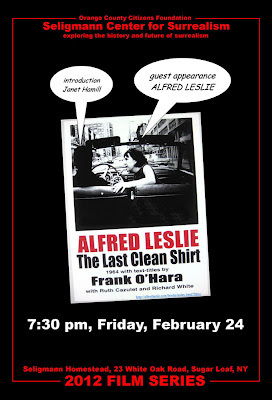
The center is named after Kurt Seligmann, who in his time was an important Surrealist artist who maintained a home and studio in Sugar Loaf. His country place was visited by many other major artists of the European avant-garde like Duchamp, Man Ray, Tanguy, Ernst, Calder, Charles Henri Ford and Meyer Shapiro. Some of these artists also made prints at the Seligmann studio. When Seligmann’s widow Arlette died, she left the building and grounds to be used for the good of the county. In addition to the Surrealism Committee, the estate currently hosts the Orange County Citizen’s Foundation and the Orange County Arts Council.
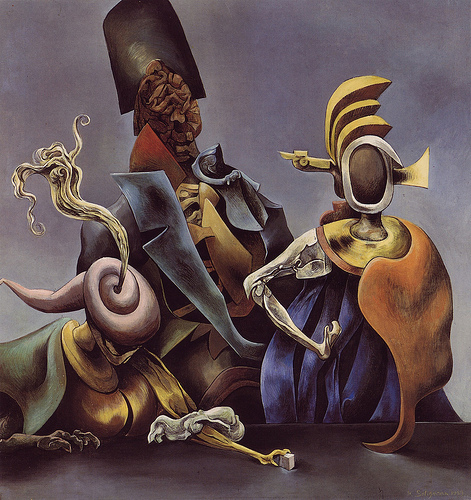 So what exactly is Surrealism? By textbook definition, it is a style of art and literature developed principally in the 20th century, stressing the subconscious or non-rational significance of imagery arrived at by automatism or the exploitation of chance effects, unexpected juxtapositions, and dreams. Poet, writer and teacher William Seaton, who presented a program of his translations from German Dada poets as well as a general account of the Dada movement (which preceded Surrealism in the European avant-garde) explained: “Surrealism relates to something deeper and more real than everyday reality. Dreams, automatic writing – all art seeking some source of information beyond the rational." Hamill added, "the Surrealists felt that the unconscious, or the sur-real (that which was above the real) revealed the truest picture of human nature. Mack offered another perspective, stating, "Surrealism is just a name given to a literary, then visual response to the shocking poverty of a military or capitalist approach to strife. The Surrealists were passionate about urging some encounter with the unconscious as a component in a balanced life.”
So what exactly is Surrealism? By textbook definition, it is a style of art and literature developed principally in the 20th century, stressing the subconscious or non-rational significance of imagery arrived at by automatism or the exploitation of chance effects, unexpected juxtapositions, and dreams. Poet, writer and teacher William Seaton, who presented a program of his translations from German Dada poets as well as a general account of the Dada movement (which preceded Surrealism in the European avant-garde) explained: “Surrealism relates to something deeper and more real than everyday reality. Dreams, automatic writing – all art seeking some source of information beyond the rational." Hamill added, "the Surrealists felt that the unconscious, or the sur-real (that which was above the real) revealed the truest picture of human nature. Mack offered another perspective, stating, "Surrealism is just a name given to a literary, then visual response to the shocking poverty of a military or capitalist approach to strife. The Surrealists were passionate about urging some encounter with the unconscious as a component in a balanced life.”
These art concepts evolved out of the Modernistic movement, starting with the art of Cezanne and his rejection of realism in favor of expressionism and the imagination. This led directly to the development of the avant-garde in Europe in the inter-war years, characterized by the advent of the Dada movement which started in Zurich Switzerland in 1916 at the Cabaret Voltaire under the direction of Hugo Ball and artists like Tristan Tzara. Surrealism took root in the 20’s with Breton and Cubism with Picasso and Braque, and its development in America occurred when European artists immigrated to the U.S. during WW 2. Seligmann was one of those artists.
Interest in Surrealism has extended beyond the Seligmann Estate. In Warwick, at the College of Poetry, Seaton organized numerous literary events, bringing in poets like Bob Holman, Janine Pommy Vega, Ed Harris, Harris Schiff, Joel Lewis and Janet Hamill. Hamill taught a course in Surrealism poetry and offered a poem of her own to illustrate Surrealism at work in writing.
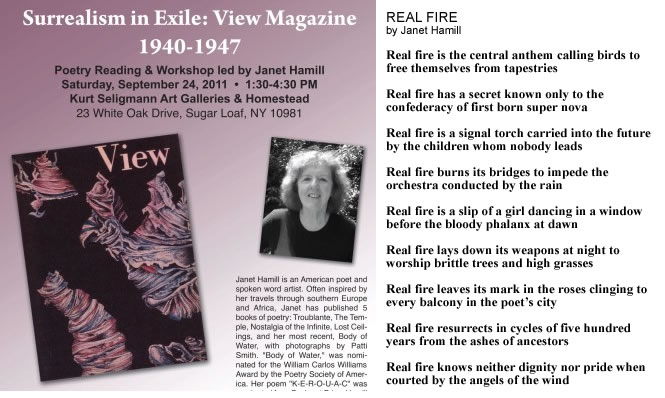 "My poem," she states, "like the films, tries to break the rules of logic, abandoning logic and exposing the subconscious through strong juxtaposition of imagery, which is the primary goal of surrealism."
"My poem," she states, "like the films, tries to break the rules of logic, abandoning logic and exposing the subconscious through strong juxtaposition of imagery, which is the primary goal of surrealism."
At the former Bookstore/Art Gallery Utopian Direction at 7 West St. in Warwick, proprietor and accomplished multi-media artist James Antonie, with his installations and Micro Gallery displays, continued to inform the public of the value of surrealism. Antonie states about his own work: "It's about the juxtaposition between the imagination and the consensus reality of what's real. Art has a way of showing another vision of reality thus changing the way people look at the world."
 Antonie continues, "My work focuses on the relationship between the microcosm and the macrocosm - the individuation process of becoming a whole person and the integration of specialized knowledge. The individuation process according to Karl Jung is the process of becoming a whole person and discovering the interrelationships of all knowledge." In essence it's the discovery of your true self.
Antonie continues, "My work focuses on the relationship between the microcosm and the macrocosm - the individuation process of becoming a whole person and the integration of specialized knowledge. The individuation process according to Karl Jung is the process of becoming a whole person and discovering the interrelationships of all knowledge." In essence it's the discovery of your true self.
At Utopian Direction, Antonie also featured the work of Jan Sawka, international painter, printmaker and stage designer for the Grateful Dead, Beat Keerl, painter and photographer who was also the manager of the Andre Emmerich Gallery on 57th St. NYC, and Michael Fabian, innovative contemporary painter and musician. The photography of Beat poets by Monica Antonie and the One More Beat event with 100,000 Poets for Change featuring the readings of Harris Schiff were just a handful of activities at Utopian Direction where one sees the influence of Surrealism on individual artists.
Perhaps one important result of the interest in Surrealism is that it has promoted interactions and connections with the creative community, which has developed into Artist Salons going on in individual homes, studios in Orange County, and the Seligmann itself, when on the last Thursday of each month, one can take part in The Artist Salon. The participants in these Salons, like they did in the past, all have their circles of friendships and influences that they bring to the table for an interesting and inspiring discourse. The intermingling of these circles of information and interconnections become an inspiration for all those involved.
Today, fine art has mixed references to popular culture with the incessant cross fertilization between 20th century art and less exalted forms of visual and audio culture which has long been known, like Picasso and Braque’s introduction of the newsprint of Parisian popular press into synthetic cubist collages; Roy Lightenstein’s careful clippings and adjusting of ordinary comic books to form his pop art paintings; Andy Warhol’s soup cans and appropriated images of the popular culture in which advertising borrows from fine art and fine art borrows from advertising; the influence of Marcel Duchamp and the readymades which brought about conceptual art; the works of Rauschenberg and Jasper Johns, in the assemblage processes of found materials.
Performance art, video art installation, earth art outside the art establishment spaces of galleries, and computer art are all evolving with a vast array of local and international artists experimenting and synthesizing all styles and genres. And for all of this, we can acknowledge the importance of the Surrealist contribution to modern and post modern art and culture.
